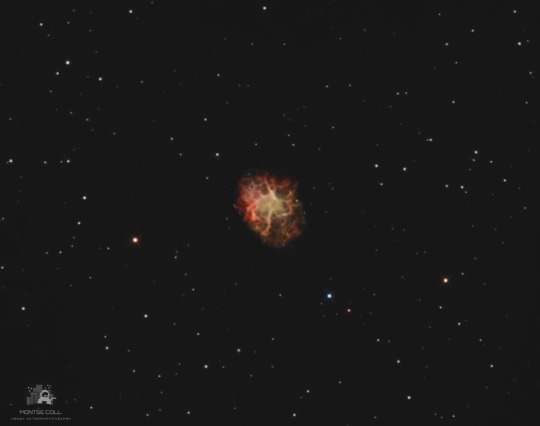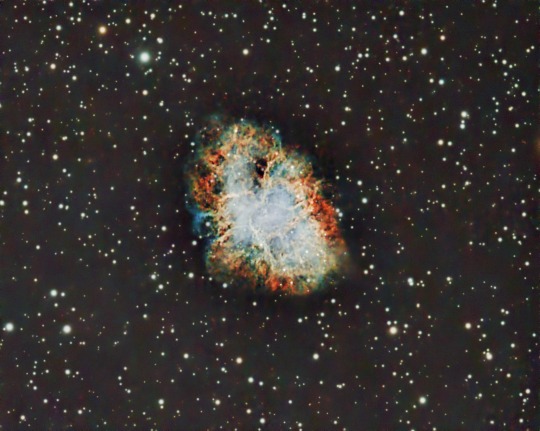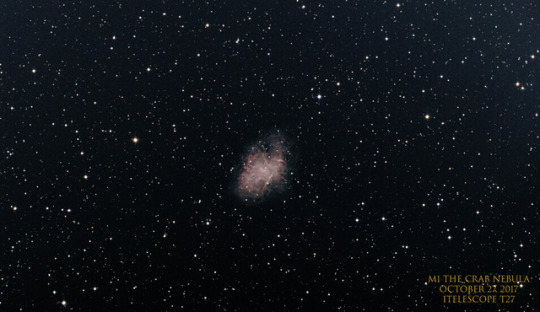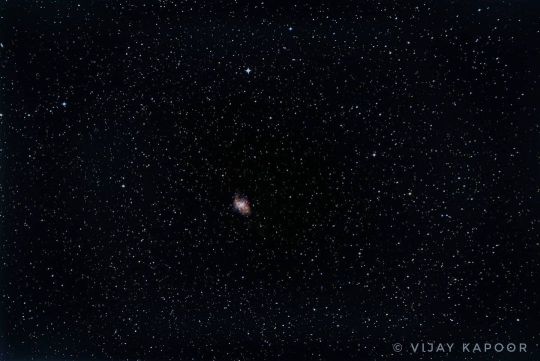#NGC 1952
Text

The Crab Nebula, M1 // Ivaylo Stoynov
#astronomy#astrophotography#nebula#emission nebula#supernova remnant#crab nebula#messier#messier 1#M1#NGC 1952#taurus#Sh2-244
310 notes
·
View notes
Text
Messier 1
The Crab Nebula, the remnants of a colossal supernova explosion nearly 1000 years ago.
The Crab Nebula,
NGC 1952, Taurus A
Image exposure:51 MinutesImage Size:38.6 x 25.6 arcminImage date:2024-01-18
These are the entrails, over ten light years in diameter, of a giant star which exploded in the Milky Way galaxy in the year 1054 CE.
The “guest star” event was separately logged at the time by Chinese, Japanese and Islamic astronomers and was so bright that it was visible in the…

View On WordPress
#amateur astronomy#Astronomy#Cosmic Focus Observatory#cosmos#Crab Nebula#deep sky#Featured#image#LBN 833#M1#Messier 1#nature#NGC 1952#photography#science#Sh2-244#Skywatcher EQ6-R#Skywatcher esprit 120#SN1054#SNR#space#supernovae remnant#Taurus A#Universe
0 notes
Text

The Crab Nebula, Messier 1, NGC 1952.
Constellation of Taurus
Distance: 6.500 ly
#astrophotography#astrophotos#astro observations#urban astrophotography#astronomy#original photographers#cosmos#universe#original photographic works#messier 1#crab nebula
20 notes
·
View notes
Text
Events 4.29
801 – An earthquake in the Central Apennines hits Rome and Spoleto, damaging the basilica of San Paolo Fuori le Mura.
1091 – Battle of Levounion: The Pechenegs are defeated by Byzantine Emperor Alexios I Komnenos.
1386 – Battle of the Vikhra River: The Principality of Smolensk is defeated by the Grand Duchy of Lithuania and becomes its vassal.
1429 – Joan of Arc arrives to relieve the Siege of Orléans.
1483 – Gran Canaria, the main island of the Canary Islands, is conquered by the Kingdom of Castile.
1521 – Swedish War of Liberation: Swedish troops defeat a Danish force in the Battle of Västerås.
1760 – French forces commence the siege of Quebec which is held by the British.
1770 – James Cook arrives in Australia at Botany Bay, which he names.
1781 – American Revolutionary War: British and French ships clash in the Battle of Fort Royal off the coast of Martinique.
1826 – The galaxy Centaurus A or NGC 5128 is discovered by James Dunlop.
1861 – Maryland in the American Civil War: Maryland's House of Delegates votes not to secede from the Union.
1862 – American Civil War: The Capture of New Orleans by Union forces under David Farragut.
1864 – Theta Xi fraternity is founded at Rensselaer Polytechnic Institute, the only fraternity to be founded during the American Civil War.
1903 – A landslide kills 70 people in Frank, in the District of Alberta, Canada.
1910 – The Parliament of the United Kingdom passes the People's Budget, the first budget in British history with the expressed intent of redistributing wealth among the British public.
1911 – Tsinghua University, one of mainland China's leading universities, is founded.
1916 – World War I: The UK's 6th Indian Division surrenders to Ottoman Forces at the Siege of Kut in one of the largest surrenders of British forces up to that point.
1916 – Easter Rising: After six days of fighting, Irish rebel leaders surrender to British forces in Dublin, bringing the Easter Rising to an end.
1944 – World War II: New Zealand-born SOE agent Nancy Wake, a leading figure in the French Resistance and the Gestapo's most wanted person, parachutes back into France to be a liaison between London and the local maquis group.
1945 – World War II: The Surrender of Caserta is signed by the commander of German forces in Italy.
1945 – World War II: Airdrops of food begin over German-occupied regions of the Netherlands.
1945 – World War II: HMS Goodall (K479) is torpedoed by U-286 outside the Kola Inlet, becoming the last Royal Navy ship to be sunk in the European theatre of World War II.
1945 – World War II: Adolf Hitler marries his longtime partner Eva Braun in a Berlin bunker and designates Admiral Karl Dönitz as his successor.
1945 – Dachau concentration camp is liberated by United States troops.
1945 – The Italian commune of Fornovo di Taro is liberated from German forces by Brazilian forces.
1946 – The International Military Tribunal for the Far East convenes and indicts former Prime Minister of Japan Hideki Tojo and 28 former Japanese leaders for war crimes.
1951 – Tibetan delegates arrive in Beijing and sign a Seventeen Point Agreement for Chinese sovereignty and Tibetan autonomy.
1952 – Pan Am Flight 202 crashes into the Amazon basin near Carolina, Maranhão, Brazil, killing 50 people.
1953 – The first U.S. experimental 3D television broadcast shows an episode of Space Patrol on Los Angeles ABC affiliate KECA-TV.
1965 – Pakistan's Space and Upper Atmosphere Research Commission (SUPARCO) successfully launches its seventh rocket in its Rehber series.
1967 – After refusing induction into the United States Army the previous day, Muhammad Ali is stripped of his boxing title.
1968 – The controversial musical Hair, a product of the hippie counter-culture and sexual revolution of the 1960s, opens at the Biltmore Theatre on Broadway, with some of its songs becoming anthems of the anti-Vietnam War movement.
1970 – Vietnam War: United States and South Vietnamese forces invade Cambodia to hunt Viet Cong.
1974 – Watergate scandal: United States President Richard Nixon announces the release of edited transcripts of White House tape recordings relating to the scandal.
1975 – Vietnam War: Operation Frequent Wind: The U.S. begins to evacuate U.S. citizens from Saigon before an expected North Vietnamese takeover. U.S. involvement in the war comes to an end.
1975 – Vietnam War: The North Vietnamese army completes its capture of all parts of South Vietnam-held Trường Sa Islands.
1986 – A fire at the Central library of the Los Angeles Public Library damages or destroys 400,000 books and other items.
1986 – The United States Navy aircraft carrier USS Enterprise becomes the first nuclear-powered aircraft carrier to transit the Suez Canal, navigating from the Red Sea to the Mediterranean Sea to relieve the USS Coral Sea.
1986 – Chernobyl disaster: American and European spy satellites capture the ruins of the No. 4 reactor at the Chernobyl Power Plant.
1991 – A cyclone strikes the Chittagong district of southeastern Bangladesh with winds of around 155 miles per hour (249 km/h), killing at least 138,000 people and leaving as many as ten million homeless.
1991 – The 7.0 Mw Racha earthquake affects Georgia with a maximum MSK intensity of IX (Destructive), killing 270 people.
1992 – Riots in Los Angeles, following the acquittal of police officers charged with excessive force in the beating of Rodney King. Over the next three days 63 people are killed and hundreds of buildings are destroyed.
1997 – The Chemical Weapons Convention of 1993 enters into force, outlawing the production, stockpiling and use of chemical weapons by its signatories.
2004 – The final Oldsmobile is built in Lansing, Michigan, ending 107 years of vehicle production.
2011 – The Wedding of Prince William and Catherine Middleton takes place at Westminster Abbey in London.
2013 – A powerful explosion occurs in an office building in Prague, believed to have been caused by natural gas, and injures 43 people.
2013 – National Airlines Flight 102, a Boeing 747-400 freighter aircraft, crashes during takeoff from Bagram Airfield in Parwan Province, Afghanistan, killing seven people.
2015 – A baseball game between the Baltimore Orioles and the Chicago White Sox sets the all-time low attendance mark for Major League Baseball. Zero fans were in attendance for the game, as the stadium was officially closed to the public due to the 2015 Baltimore protests.
1 note
·
View note
Text

M1 - Crab Nebula
See full resolution image at: https://www.astrobin.com/rejqjs/
The Crab Nebula (catalogue designations M1, NGC 1952, Taurus A) is a supernova remnant and pulsar wind nebula in the constellation of Taurus. The common name comes from a drawing that somewhat resembled a crab with arms produced by William Parsons, 3rd Earl of Rosse, in 1842 or 1843 using a 36-inch (91 cm) telescope. The nebula was discovered by English astronomer John Bevis in 1731. It corresponds with a bright supernova recorded by Chinese astronomers in 1054 as a guest star. The nebula was the first astronomical object identified that corresponds with a historically-observed supernova explosion.
The nebula was independently rediscovered in 1758 by Charles Messier as he was observing a bright comet. Messier catalogued it as the first entry in his catalogue of comet-like objects; in 1757, Alexis Clairaut reexamined the calculations of Edmund Halley and predicted the return of Halley's Comet in late 1758. The exact time of the comet's return required the consideration of perturbations to its orbit caused by planets in the Solar System such as Jupiter, which Clairaut and his two colleagues Jérôme Lalande and Nicole-Reine Lepaute carried out more precisely than Halley, finding that the comet should appear in the constellation of Taurus. It was in searching in vain for the comet that Charles Messier found the Crab Nebula, which he at first thought to be Halley's comet. After some observation, noticing that the object that he was observing was not moving across the sky, Messier concluded that the object was not a comet. Messier then realized the usefulness of compiling a catalogue of celestial objects of a cloudy nature, but fixed in the sky, to avoid incorrectly cataloguing them as comets. This realization led him to compile the "Messier catalogue"
At an apparent magnitude of 8.4, comparable to that of Saturn's moon Titan, it is not visible to the naked eye but can be made out using binoculars under favorable conditions. The nebula lies in the Perseus Arm of the Milky Way galaxy, at a distance of about 2.0 kiloparsecs (6,500 ly) from Earth. It has a diameter of 3.4 parsecs (11 ly), corresponding to an apparent diameter of some 7 arcminutes, and is expanding at a rate of about 1,500 kilometres per second (930 mi/s), or 0.5% of the speed of light.
At the center of the nebula lies the Crab Pulsar, a neutron star 28–30 kilometres (17–19 mi) across with a spin rate of 30.2 times per second, which emits pulses of radiation from gamma rays to radio waves. At X-ray and gamma ray energies above 30 keV, the Crab Nebula is generally the brightest persistent gamma-ray source in the sky, with measured flux extending to above 10 TeV. The nebula's radiation allows detailed study of celestial bodies that occult it. In the 1950s and 1960s, the Sun's corona was mapped from observations of the Crab Nebula's radio waves passing through it, and in 2003, the thickness of the atmosphere of Saturn's moon Titan was measured as it blocked out X-rays from the nebula.
This RGB image is a total of a little under 6 hours of integration over 2 nights (2/18/24 and 2/25/24) consisting of:
- 190 x 60s light frames
- 61 x 120s light frames
- 10 x 180s light frames
Processed in PixInsight using the new GradientCorrection tool (which really helped with the moon-induced gradients on the data taken 2/18).
Celestron C9.25 Edge at F/10
ZWO ASI2600MC Pro Camera
Optolong L-Pro filter
ZWO AM5 mount
Astromania 50mm f/4 Guide Scope
ZWO ASI120MM Mini Guide Camera
ZWO ASIAIR plus controller
0 notes
Text
Origin: Another race here which has its origin in the stars is the group variously called the Bigfoot, Yeti, Sasquatch, and the “Abominable Snowman”. Sasquatch is an intelligent, telepathic extraterrestrial race that has taken residence within Earth in natural secluded regions. Sasquatches are intelligent, sensitive, social among themselves but retiring near Humans, psychic persons who happen to have heavy body hair, the coloration of which adapts to their environment.
Sasquatches live in temperate-to-arctic climatic zones on Earth. In temperate zones, their hair is brown to dark, while in arctic climate zones their hair is white. Sasquatches formerly lived on a cooling planet orbiting a dying star 6550 light-years from Earth. Around 9550 B.C., Star Nations observed their plight and transplanted them to Earth to set up living here for survival. 2041 years later, in 7509 B.C., the dying star whose planet had been the Sasquatches’ homeworld went critical and blew up into a supernova we know as the Crab Nebula (M1; NGC #1952; SN 1054).
The light from that supernova first reached Earth in 1054 A.D. and was recorded by Chinese and Arab astronomers. Luckily by the time of that supernova, the Sasquatch were well settled into life on Earth. Being psychic the Sasquatch looking up and seeing that bright star suddenly appears in the sky and remaining visible for two years knew that it was what was left of their homeworld, a neutron star surrounded by glowing filaments made up of the ionized elements of which the star’s atmosphere had been composed. The Sasquatch knew that they had moved away from their homeworld just in time.
(Source)
0 notes
Photo

M1 [NGC 1952] Crab Nebula Supernova Remnant
#M1#NGC 1952#Crab Nebula Supernova Remnant#Crab Nebula#Supernova Remnant#nasa#stargazing#astrophoto#astrophotography#galaxy#astronomy#universe#space#nebula#spinningblueball#thespinningblueball#milky way#milky way galaxy#milkywaygalaxy#spacephotography#nightsky#starrynight#milkywayphotography#astrophotos#starscape#star#cosmos#telescope#hubble#chandra
137 notes
·
View notes
Photo

The Crab
42 notes
·
View notes
Photo

Crab Nebula (NGC 1952)
[Multiwave Photo]
The aftermath of a supernova observed by John Bevis in 1731. The supernova itself was recorded by Chinese astronomers in 1054 A.D, which initially lasted about 23 days.
Commonly known as M1, the Crab Nebula is the first object recorded in the Messier catalogue. The supernova contains a pulsar located at its center, and its diameter extends to about 10 light years. The nebula can easily be seen with a basic telescope in the Taurus constellation at approximately RA 5 34 32 Dec +22 0 52.
An interesting perspective about its discovery (1054 A.D.):
“Nearly a thousand years ago, on a late-April morning in the year 1054, groggy Chinese astronomers awakened to the spectacle of a blazing new star in the daytime sky. This “guest star”, as they called it, appeared out of nowhere, shone with a reddish-white light some six times brighter than Venus, then slowly faded from daytime view after 23 days. What they observed, of course, was a supernova, a massive star suddenly collapsed upon itself before exploding with as much energy as an entire galaxy.” (source)
#crab nebula#ngc 1952#astronomy#galaxies#nebula#deep space#hubble#photograph#hubble space telescope#nasa#ancient astronomy#cosmos#stars#messier#amateur astronomy#amateur astronomers
40 notes
·
View notes
Text

The Crab Nebula, M1 // NHAuniverse
The Crab Nebula is the only supernova remnant in the catalog. This was not an original discovery by Messier, having been discovered several decades earlier in 1731. The name comes from a drawing of the object that somewhat resembles a crab with arms produced by William Parsons in 1842.
#astronomy#astrophotography#messier marathon#nebula#emission nebula#supernova remnant#crab nebula#messier#messier 1#M1#NGC 1952#Taurus A#taurus
59 notes
·
View notes
Photo

I don’t think I have the blending quite right but this image is a composite of Luminescence, Red, Green, Blue, Ha and OIII frames each with a 300s exposure. Some of the filaments have come out quite nicely though. The loss of contrast to at the top of the image was due to the unfortunate position of the Moon.
The Crab Nebula, Messier 1 (M1, NGC 1952), is the most famous and conspicuous known supernova remnant, the expanding cloud of gas created in the explosion of a star as supernova which was observed in the year 1054 AD.
#nebula#Nebulosity#cosmos#cosmology#supernova#remnent#space#stars#dso#crab#messier#m1#itelescope#t27#ngc 1952#1952#ngc#OIII#ha#hydrogen-alpha#LRGB#night#sky
1 note
·
View note
Note
Damn, are you a supernova? Because you’re absolutely stunning and truly a testament to nature’s beauty :3

(M1, NGC 1952, Taurus A - "Crab Nebula")
14 notes
·
View notes
Photo

*Crab Nebula - M1* The Crab Nebula (catalogue designations M1, NGC 1952, Taurus A) is a supernova remnant and pulsar wind nebula in the constellation of Taurus. The common name comes from William Parsons, 3rd Earl of Rosse, who observed the object in 1840 using a 36-inch telescope and produced a drawing that looked somewhat like a crab. The nebula was discovered by English astronomer John Bevis in 1731, and it corresponds with a bright supernova recorded by Chinese astronomers in 1054. The nebula was the first astronomical object identified that corresponds with a historical supernova explosion. *Observation data* Distance to Earth: 6,523 light years Distance: 6500±1600 ly (2000±500 pc) Constellation: Taurus Absolute magnitude (V): −3.1±0.5 Apparent dimensions (V): 420″ × 290″ Coordinates: RA 5h 34m 32s | Dec +22° 0′ 52″ *Physical Characteristics* Radius: ~5.5 ly (~1.7 pc) Absolute magnitude (V): −3.1±0.5 Notable features: Optical pulsar Designations: Messier 1, NGC 1952, Taurus A, Sh2-244 *Captured on*: __Feb. 14, 2021... *Equipment*: __TSOptics Photon 12" F4 Advanced Newtonian... __TSOptics 0.95 reducer and coma corrector... __SoftwareBisque Paramount MX Mount... __Nikon D750 DSLR Camera .... *Processing Details*: __48 x 30 sec. each frame (24 min. data) __17 dark frames __ISO-1270 __Stacked in DSS __Processed in PixInsight __Enhanced in LightRoom & Snapseed *Location:* __Chiguru Farm, Bilikal Forest, Karnataka *Sky Conditions* __Bortle Scale 3.8 __Clear Sky __Few surrounding villages lights interference #CrabNebula #astrophysics #nightsky #astronomy #softwarebisque #astrophotography #starrynight #cosmos #AstroPhotographyIndia #nikon #Travel #karnataka #india © Vijay Kapoor Follow My Instagram for More pics: http://Instagram.com/lunar_mountains_climber https://www.instagram.com/p/CLqqYeNJVcZ/?igshid=qfm1kjml0apz
#crabnebula#astrophysics#nightsky#astronomy#softwarebisque#astrophotography#starrynight#cosmos#astrophotographyindia#nikon#travel#karnataka#india
3 notes
·
View notes
Video
NASA's Great Observatories Help Astronomers Build a 3D Visualization of an Exploded Star by NASA's Marshall Space Flight Center
Via Flickr:
This new multiwavelength image of the Crab Nebula combines X-ray light from the Chandra X-ray Observatory (in blue) with visible light from the Hubble Space Telescope (in yellow) and infrared light seen by the Spitzer Space Telescope (in red). This particular combination of light from across the electromagnetic spectrum highlights the nested structure of the pulsar wind nebula. The X-rays reveal the beating heart of the Crab, the neutron-star remnant from the supernova explosion seen almost a thousand years ago. This neutron star is the super-dense collapsed core of an exploded star and is now a pulsar that rotates at a blistering rate of 30 times per second. A disk of X-ray-emitting material, spewing jets of high-energy particles perpendicular to the disk, surrounds the pulsar. The infrared light in this image shows synchrotron radiation, formed from streams of charged particles spiraling around the pulsar's strong magnetic fields. The visible light is emission from oxygen that has been heated by higher-energy (ultraviolet and X-ray) synchrotron radiation. The delicate tendrils seen in visible light form what astronomers call a "cage" around the rich tapestry of synchrotron radiation, which in turn encompasses the energetic fury of the X-ray disk and jets. These multiwavelength interconnected structures illustrate that the pulsar is the main energy source for the emission seen by all three telescopes. The Crab Nebula resides 6,500 light-years from Earth in the constellation Taurus. Image credit: NASA, ESA and J. DePasquale (STScI) and R. Hurt (Caltech/IPAC) Read more More about the Chandra X-ray Observatory NASA Media Usage Guidelines
#NASA#NASA's Marshall Space Flight Center#NASA Marshall#Marshall#MSFC#Chandra X-Ray Observatory#CXO#Solar System & Beyond#astronomy#astrophysics#X-ray#nebula#supernova#pulsar#Hubble Space Telescope#HST#Spitzer Space Telescope#Crab Nebula#M1#NGC 1952#Now Playing#13th#January#2020#January 13th 2020
0 notes
Photo

M1 [NGC 1952] Crab Nebula
#M1#Messier 1#NGC 1952#Crab Nebula#nasa#stargazing#astrophoto#astrophotography#galaxy#astronomy#universe#space#nebula#spinningblueball#thespinningblueball#milky way#milky way galaxy#milkywaygalaxy#spacephotography#nightsky#starrynight#milkywayphotography#astrophotos#starscape#star#cosmos#telescope#hubble#chandra#spitzer
134 notes
·
View notes

